The caretaker at Panikhar arranged for a Tata Sumo to drive us to Rangdum, our 2nd stop in Suru valley, for Rs.3,000; a little steep for the distance, but we had no other options. 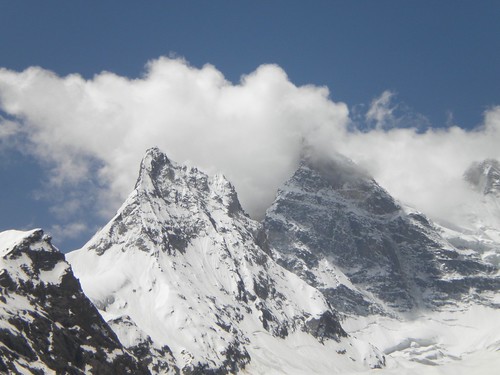 We stopped in the neighboring village of Prakachik to take pictures of the famed twin peaks, Nun & Kun, which tower over the village magnificently. At 7135m in height, Nun is the highest peak in the Indian side of the Himalayan range. The village itself looked absolutely stunning with a brand new road running through it, lush green fields and beautifully maintained Ladakhi homes. Although it looked ready for vehicular traffic we were forced to use the old, more circuitous road, which ran above the village on the neighboring hill – it gave us a great view of the village! However, past Prakachik, the scenery changed quite drastically. The fields slowly disappeared and the river bed turned into a rocky plain with patches of grassy meadows. Flitting across this rocky landscape were the cute little
We stopped in the neighboring village of Prakachik to take pictures of the famed twin peaks, Nun & Kun, which tower over the village magnificently. At 7135m in height, Nun is the highest peak in the Indian side of the Himalayan range. The village itself looked absolutely stunning with a brand new road running through it, lush green fields and beautifully maintained Ladakhi homes. Although it looked ready for vehicular traffic we were forced to use the old, more circuitous road, which ran above the village on the neighboring hill – it gave us a great view of the village! However, past Prakachik, the scenery changed quite drastically. The fields slowly disappeared and the river bed turned into a rocky plain with patches of grassy meadows. Flitting across this rocky landscape were the cute little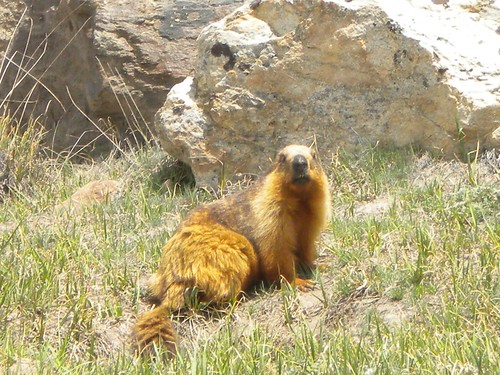 Himalayan Marmots. They looked like large squirrels with a thick, furry coat. It was quite entertaining to watch them scurry about and dive into invisible holes between the rocks as we drove by.
Himalayan Marmots. They looked like large squirrels with a thick, furry coat. It was quite entertaining to watch them scurry about and dive into invisible holes between the rocks as we drove by.
At an elevation of around 3600m and located almost at the center of the road leading south to Padum from Kargil, Rangdum is the first Buddhist village we encountered. It sits at the edge of Suru valley, some 40kms north of Penzi La pass, which leads to Zanskar valley. From what we had read (or rather misread), we had imagined Rangdum to be a decent-sized village (something like Sanku) with a reasonable number of stay and eating options. So when we pulled into a small settlement of about 20 Ladakhi homes and 2 tea shops (out of which, one wasn’t even open), we were quite shocked! Rangdum made Panikher and Prakachik look rich and well-developed.
Our driver drove us first to a small shack, which is a police check post where all visitors must register before proceeding to Zanskar valley. After completing the formalities, we were then led to the local tourist bungalow, which wasn’t quite as nice as the one in Panikher. It had just about 2 double rooms with a shared bathroom and a dusty dining room. Since there were no other options, we dropped our bags there, paid off the driver and then walked out in search of lunch.
While driving into Rangdum, I had started to feel a little uneasy. At first I wasn’t sure what it was but soon realized that I was having difficulty breathing and feeling slightly nauseous; the first signs of altitude sickness had set in. Madhu had had his share in Himachal and now it was my turn. When we walked towards the tea stall, the 5-minute walk on a flat surface felt like I was climbing a 45degree-inclined hill; it was terribly tiring and I wondered if I would have to stay indoors for the rest of the afternoon. After a refreshing lunch of Dal, Rice and Chai, though, I felt a lot better and strong enough to explore Rangdum.
The main attraction of Rangdum is its monastery, 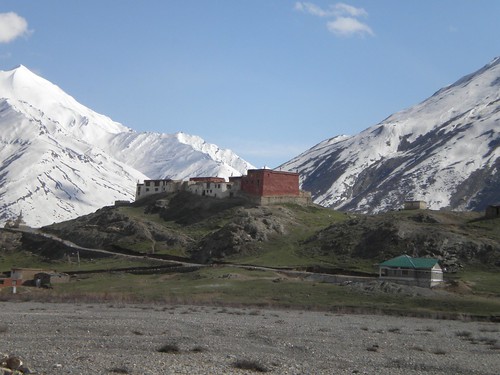 which is located 5kms south of the village. But what makes it a must-stay place is its unbelievable setting! The vast open, bare valley, fringed with rocky, snow-covered mountains is the prettiest and most awe-inspiring place I’ve ever set foot in till-date! The rocky river-bed on which the tiny village sits provides a flat, barren platform from which one can gape open-mouthed at the mighty stone and snow formations around. The only way to explore/experience Rangdum is by walking around and therefore, in spite of not feeling too good, I was more than willing to get going.
which is located 5kms south of the village. But what makes it a must-stay place is its unbelievable setting! The vast open, bare valley, fringed with rocky, snow-covered mountains is the prettiest and most awe-inspiring place I’ve ever set foot in till-date! The rocky river-bed on which the tiny village sits provides a flat, barren platform from which one can gape open-mouthed at the mighty stone and snow formations around. The only way to explore/experience Rangdum is by walking around and therefore, in spite of not feeling too good, I was more than willing to get going.
The river bed in Suru valley is full of tiny rivulets and streams 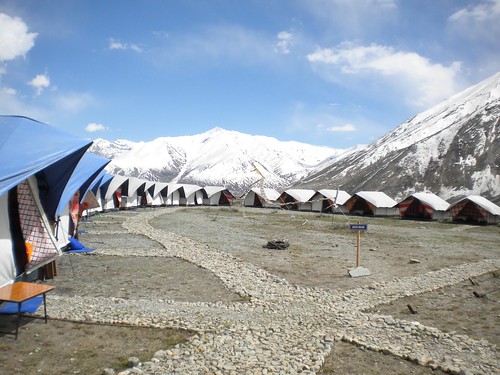 formed by the melting snow on the mountains. So, even though it would have been faster to walk on it to the monastery, we had to get on to the main road, which heads south all the way to Padum. It was quite a scenic, peaceful walk as there was hardly any traffic on the road. A kilometer beyond the village we came upon a resort with tent accommodations set about 500m away from the road on the river bed. We walked over for a closer look and were amazed to find lovely, colorful tents with double-beds, shared bathrooms and a large,
formed by the melting snow on the mountains. So, even though it would have been faster to walk on it to the monastery, we had to get on to the main road, which heads south all the way to Padum. It was quite a scenic, peaceful walk as there was hardly any traffic on the road. A kilometer beyond the village we came upon a resort with tent accommodations set about 500m away from the road on the river bed. We walked over for a closer look and were amazed to find lovely, colorful tents with double-beds, shared bathrooms and a large,  well-decorated dining tent. Unfortunately, the resort was not yet open for the season and the staff was busy setting things up. The accommodations include all meals and some activities like trekking in the region. It all looked and sounded wonderful! If it had been ready, I’m sure Madhu and I would have moved out of the tourist bungalow and checked in here immediately. The staff manager had brought along a cute puppy with whom we played for a while before setting off towards the monastery.
well-decorated dining tent. Unfortunately, the resort was not yet open for the season and the staff was busy setting things up. The accommodations include all meals and some activities like trekking in the region. It all looked and sounded wonderful! If it had been ready, I’m sure Madhu and I would have moved out of the tourist bungalow and checked in here immediately. The staff manager had brought along a cute puppy with whom we played for a while before setting off towards the monastery.
The isolated location of the village of Rangdum became 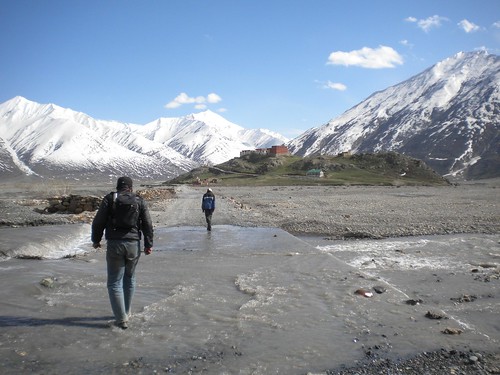 more evident as we lost sight of it after a couple of kilometers and found ourselves literally in the middle of nowhere; there was just the river bed to our right, the winding road before us and mountains all around – a truly magical landscape! Even though it was a 5km hike to the monastery, it was an easy walk as the road is pretty flat. A kilometer before the monastery, we had to cross a couple of shallow streams, which flowed down from the mountains, across the road and into the river bed. It was quite a scenic, memorable walk!
more evident as we lost sight of it after a couple of kilometers and found ourselves literally in the middle of nowhere; there was just the river bed to our right, the winding road before us and mountains all around – a truly magical landscape! Even though it was a 5km hike to the monastery, it was an easy walk as the road is pretty flat. A kilometer before the monastery, we had to cross a couple of shallow streams, which flowed down from the mountains, across the road and into the river bed. It was quite a scenic, memorable walk!
Built in the 18th century, Rangdum monastery sits atop a small hillock and is visible from afar because of the flat expanse of the valley 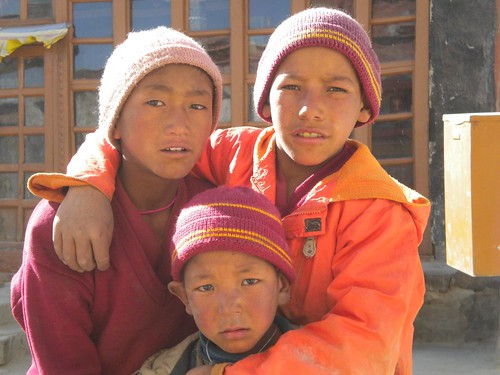 around. At the base of the hillock is an army post where we were asked the purpose of our visit and then waved off to continue to the monastery. Instead of using the motor-able road up to it, we used steep, narrow foot-trails that led us up to its rear entrance. There we were greeted by three giggling young Lamas. They welcomed us with the word ‘Juley’. In Ladakhi, it means Thank You, Hello and Welcome, all rolled into one!
around. At the base of the hillock is an army post where we were asked the purpose of our visit and then waved off to continue to the monastery. Instead of using the motor-able road up to it, we used steep, narrow foot-trails that led us up to its rear entrance. There we were greeted by three giggling young Lamas. They welcomed us with the word ‘Juley’. In Ladakhi, it means Thank You, Hello and Welcome, all rolled into one!
The monastery’s outer building where the Lamas live and teach the young Lamas, is a 2-storey brick structure in typical Ladakhi architecture: 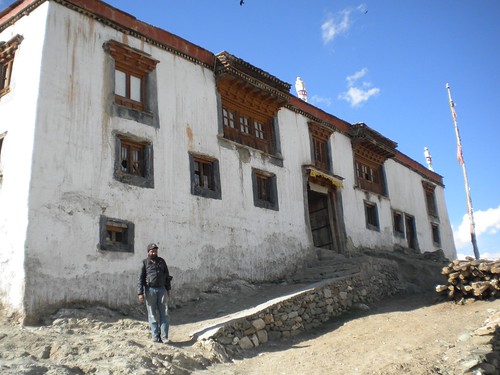 squat, square and flat-roofed. Inside, the building encompasses a small courtyard, which leads to the main prayer hall. Although, the hall was locked up when we entered the courtyard, the young Lamas fetched a senior Lama, who graciously opened the doors for us. As we stepped into the sacred interiors what struck me most was the simplicity of the place; quite in contrast to what we saw in Himachal. There the monasteries were all newer and brighter with plush interiors and freshly painted walls. This Ladakhi one was old with peeling walls, tattered Tangkha paintings and worn silk tassels on pillars, but it was far more atmospheric! A serene Buddha idol sat enclosed behind a glass front at the center of the far wall. Unfortunately (and understandably), photography was not allowed within.
squat, square and flat-roofed. Inside, the building encompasses a small courtyard, which leads to the main prayer hall. Although, the hall was locked up when we entered the courtyard, the young Lamas fetched a senior Lama, who graciously opened the doors for us. As we stepped into the sacred interiors what struck me most was the simplicity of the place; quite in contrast to what we saw in Himachal. There the monasteries were all newer and brighter with plush interiors and freshly painted walls. This Ladakhi one was old with peeling walls, tattered Tangkha paintings and worn silk tassels on pillars, but it was far more atmospheric! A serene Buddha idol sat enclosed behind a glass front at the center of the far wall. Unfortunately (and understandably), photography was not allowed within.
We exited the monastery via its main entrance gate and then walked back down along the motor-able road. The army guys gave us a warm smile as we passed by. The two streams that we had crossed on our way to the monastery had swelled a little more in the afternoon heat, making the 2nd crossing a little treacherous. After that the walk back to Rangdum village was pretty uneventful and we got there just when it had started to get dark. The lone tea shop had closed for the day so we panicked for a few minutes wondering if we would have to go without dinner. But, luckily, the caretaker showed up and arranged for a simple meal of Dal and Rice to be brought to our room.
By the time our dinner was brought, the temperature had dropped considerably and Madhu and I sat in our rooms wearing our jackets, socks and woolen caps, trying our best to stay warm. Yet we practically shivered through our meal. The caretaker assured us that Padum would be relatively warmer and that made me feel slightly better. The 10km hike around Rangdum had left me feeling weak, dizzy and tired; the symptoms of altitude sickness had returned. I knew then that it was going to be a rough night.


wow! such an exciting trip!
Hey Madhu,
Do you have a close up of the marmot? Send me a couple of high res images.
Vanaja
Hi Vanaja,
Savi had clicked that one using her camera (P&S). I didn’t take any closeups because I was too lazy to change the lens 🙂
I think the one on the blog is the only marmot pic we have. In any case I shall email it to you.
Cheers,
Madhu
Never fails to bring a smile, a post from the Ladakh region. It’s magical. Wonderful post. 🙂
Very true, Jatin.
It has been a while.
Sure want to head back again.